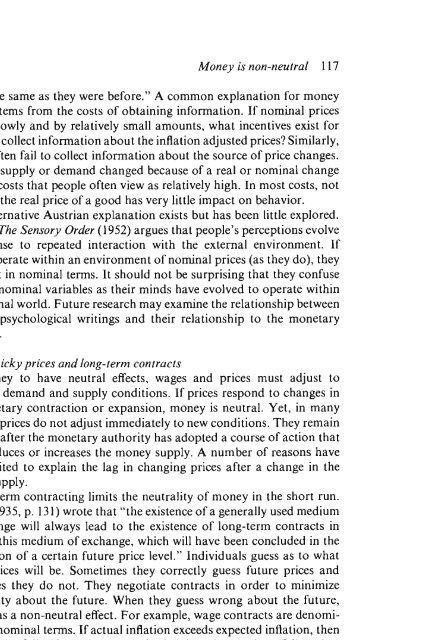Handbook on Contemporary Austrian Economics
Handbook on Contemporary Austrian Economics
Handbook on Contemporary Austrian Economics
Create successful ePaper yourself
Turn your PDF publications into a flip-book with our unique Google optimized e-Paper software.
M<strong>on</strong>ey is n<strong>on</strong>-neutral 117<br />
or less the same as they were before." A comm<strong>on</strong> explanati<strong>on</strong> for m<strong>on</strong>ey<br />
illusi<strong>on</strong> stems from the costs of obtaining informati<strong>on</strong>. If nominal prices<br />
change slowly and by relatively small amounts, what incentives exist for<br />
people to collect informati<strong>on</strong> about the inflati<strong>on</strong> adjusted prices Similarly,<br />
people often fail to collect informati<strong>on</strong> about the source of price changes.<br />
Whether supply or demand changed because of a real or nominal change<br />
involves costs that people often view as relatively high. In most costs, not<br />
knowing the real price of a good has very little impact <strong>on</strong> behavior.<br />
An alternative <strong>Austrian</strong> explanati<strong>on</strong> exists but has been little explored.<br />
Hayek's The Sensory Order (1952) argues that people's percepti<strong>on</strong>s evolve<br />
in resp<strong>on</strong>se to repeated interacti<strong>on</strong> with the external envir<strong>on</strong>ment. If<br />
people operate within an envir<strong>on</strong>ment of nominal prices (as they do), they<br />
will think in nominal terms. It should not be surprising that they c<strong>on</strong>fuse<br />
real and nominal variables as their minds have evolved to operate within<br />
the nominal world. Future research may examine the relati<strong>on</strong>ship between<br />
Hayek's psychological writings and their relati<strong>on</strong>ship to the m<strong>on</strong>etary<br />
ec<strong>on</strong>omy.<br />
8.3.4 Sticky prices and l<strong>on</strong>g-term c<strong>on</strong>tracts<br />
For m<strong>on</strong>ey to have neutral effects, wages and prices must adjust to<br />
changing demand and supply c<strong>on</strong>diti<strong>on</strong>s. If prices resp<strong>on</strong>d to changes in<br />
the m<strong>on</strong>etary c<strong>on</strong>tracti<strong>on</strong> or expansi<strong>on</strong>, m<strong>on</strong>ey is neutral. Yet, in many<br />
markets, prices do not adjust immediately to new c<strong>on</strong>diti<strong>on</strong>s. They remain<br />
the same after the m<strong>on</strong>etary authority has adopted a course of acti<strong>on</strong> that<br />
either reduces or increases the m<strong>on</strong>ey supply. A number of reas<strong>on</strong>s have<br />
been posited to explain the lag in changing prices after a change in the<br />
m<strong>on</strong>ey supply.<br />
L<strong>on</strong>g-term c<strong>on</strong>tracting limits the neutrality of m<strong>on</strong>ey in the short run.<br />
Hayek (1935, p. 131) wrote that "the existence of a generally used medium<br />
of exchange will always lead to the existence of l<strong>on</strong>g-term c<strong>on</strong>tracts in<br />
terms of this medium of exchange, which will have been c<strong>on</strong>cluded in the<br />
expectati<strong>on</strong> of a certain future price level." Individuals guess as to what<br />
future prices will be. Sometimes they correctly guess future prices and<br />
sometimes they do not. They negotiate c<strong>on</strong>tracts in order to minimize<br />
uncertainty about the future. When they guess wr<strong>on</strong>g about the future,<br />
m<strong>on</strong>ey has a n<strong>on</strong>-neutral effect. For example, wage c<strong>on</strong>tracts are denominated<br />
in nominal terms. If actual inflati<strong>on</strong> exceeds expected inflati<strong>on</strong>, then<br />
the real wage falls. If the workers realized their real wages have fallen, they<br />
may resp<strong>on</strong>d by reducing productivity.<br />
New Keynesian models formalized and extended the sources of price<br />
stickiness. Menu costs offered a simple, example. When price changes<br />
are small, it may be too costly to print up new menus. The benefits from

















